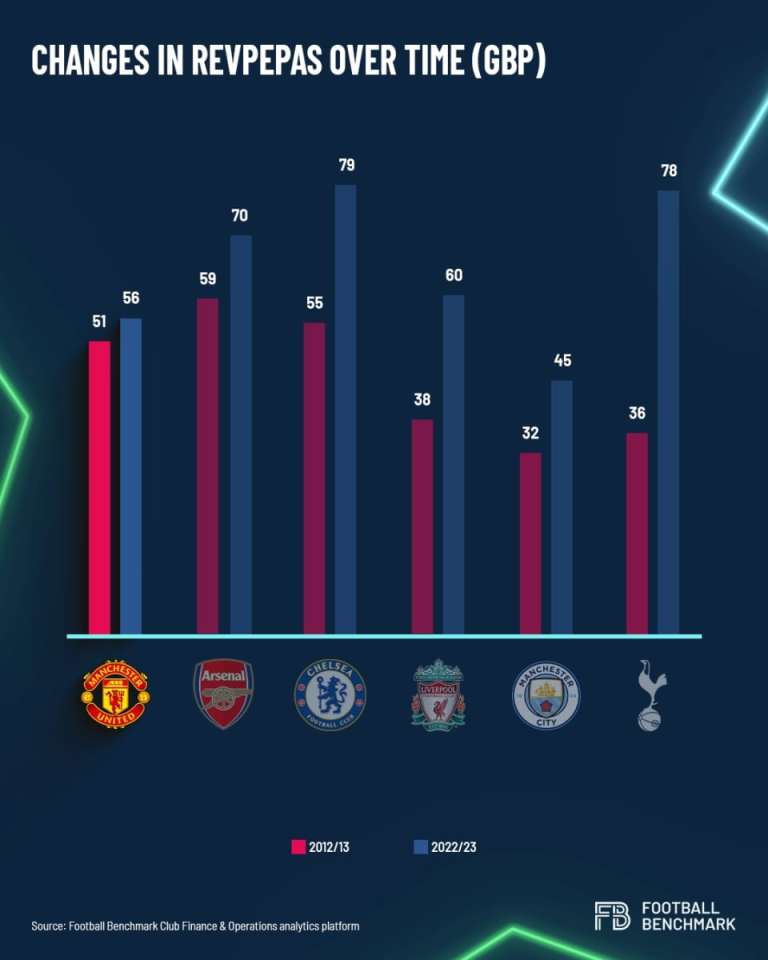Three charts which show why Manchester United want a new stadium

Sir Jim Ratcliffe has made renovating Old Trafford or building a brand new stadium one of his top priorities since investing in Manchester United.
Ratcliffe wants the club’s home to be a modern, 100,000-seater stadium and has assembled a task force that includes Lord Coe and Gary Neville to shape the plans.
The project is expected to cost up to £2bn but it is hoped that it will end up paying for itself. These three charts, collated by independent consultancy Football Benchmark, illustrate why Manchester United are so keen on a new stadium.
Revenue Per Event Per Available Seat
Old Trafford was once the benchmark for Premier League stadia but, having last been upgraded in 2006, has been left behind by many rivals.
At the same time, the club’s dwindling fortunes on the field have impacted their ability to raise ticket prices as much as some of their peers.
The result is that the amount of money that Manchester United derive from each seat – Revenue Per Event Per Available Seat – is now the second least of the Premier League’s ‘Big Six’ and has barely grown in the past decade.
By contrast, Tottenham Hotspur’s new stadium has seen them more than double their RevPEPAS, while Liverpool and Chelsea’s have increased by around 50 per cent.

Operating Revenue
Manchester United used to be the undisputed financial powerhouse of English football but in recent years have been overtaken by Manchester City.
Like other leading European clubs, they have benefited from the growth in global interest in football and the investment from commercial partners that has followed.
But Liverpool and Tottenham Hotspur have made up significant ground in terms of operating revenue, both in part due to stadium improvements.
Real Madrid and Barcelona remain out of reach of Manchester United and the Spanish giants are both set to benefit from lucrative new stadia too.

Squad Costs
Manchester United’s revenue from media rights and commercial streams may have continued to grow but their outlay on players has gone up even more.
The club’s staff costs rocketed from £183m a year in 2012-13 to £408m in 2021-22, while some chunky transfer fees have also created a long-lasting burden.
Amortisation of player registrations – the cost of signings spread over the length of their initial contract – went from £42m a year in 2012-13 to an eye-watering £170m in 2022-23.
Ratcliffe has swung the axe in a bid to cut costs since making his investment less than a year ago but, with some big hires too, the benefits may not be felt for a while.

Summary
Media rights value growth has turbo-charged the boom in income for Europe’s top clubs, and nowhere more so than in the market-leading Premier League.
That stream is expected to plateau or even decline, while the sponsorship market is already a mature one, thanks in part to the trailblazing likes of Manchester United.
Recently, and inspired by modern US mega-stadia such as the SoFi in Los Angeles, football clubs have looked to turn their homes into venues that can make money year-round.
Ratcliffe’s intentions for Old Trafford are in keeping with this trend and can at least provide Manchester United with the financial ammunition to return to the top of the game.
